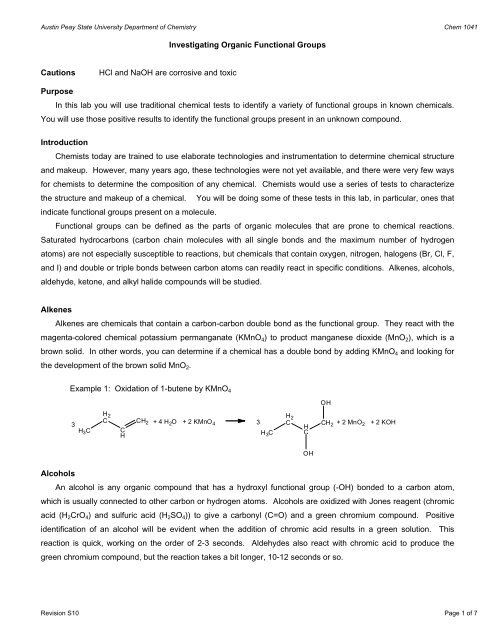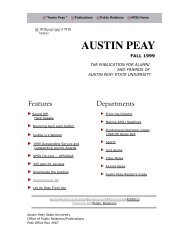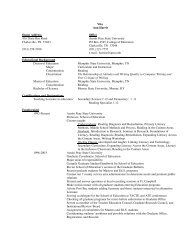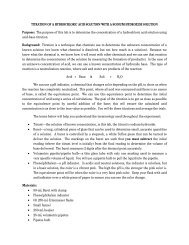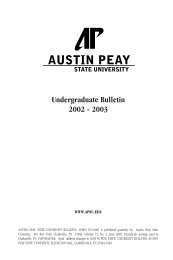Investigating Organic Functional Groups Cautions HCl and NaOH ...
Investigating Organic Functional Groups Cautions HCl and NaOH ...
Investigating Organic Functional Groups Cautions HCl and NaOH ...
You also want an ePaper? Increase the reach of your titles
YUMPU automatically turns print PDFs into web optimized ePapers that Google loves.
Austin Peay State University Department of Chemistry Chem 1041<br />
<strong>Investigating</strong> <strong>Organic</strong> <strong>Functional</strong> <strong>Groups</strong><br />
<strong>Cautions</strong><br />
<strong>HCl</strong> <strong>and</strong> <strong>NaOH</strong> are corrosive <strong>and</strong> toxic<br />
Purpose<br />
In this lab you will use traditional chemical tests to identify a variety of functional groups in known chemicals.<br />
You will use those positive results to identify the functional groups present in an unknown compound.<br />
Introduction<br />
Chemists today are trained to use elaborate technologies <strong>and</strong> instrumentation to determine chemical structure<br />
<strong>and</strong> makeup. However, many years ago, these technologies were not yet available, <strong>and</strong> there were very few ways<br />
for chemists to determine the composition of any chemical. Chemists would use a series of tests to characterize<br />
the structure <strong>and</strong> makeup of a chemical. You will be doing some of these tests in this lab, in particular, ones that<br />
indicate functional groups present on a molecule.<br />
<strong>Functional</strong> groups can be defined as the parts of organic molecules that are prone to chemical reactions.<br />
Saturated hydrocarbons (carbon chain molecules with all single bonds <strong>and</strong> the maximum number of hydrogen<br />
atoms) are not especially susceptible to reactions, but chemicals that contain oxygen, nitrogen, halogens (Br, Cl, F,<br />
<strong>and</strong> I) <strong>and</strong> double or triple bonds between carbon atoms can readily react in specific conditions. Alkenes, alcohols,<br />
aldehyde, ketone, <strong>and</strong> alkyl halide compounds will be studied.<br />
Alkenes<br />
Alkenes are chemicals that contain a carbon-carbon double bond as the functional group. They react with the<br />
magenta-colored chemical potassium permanganate (KMnO 4 ) to product manganese dioxide (MnO 2 ), which is a<br />
brown solid. In other words, you can determine if a chemical has a double bond by adding KMnO 4 <strong>and</strong> looking for<br />
the development of the brown solid MnO 2 .<br />
Example 1: Oxidation of 1-butene by KMnO 4<br />
OH<br />
H 2<br />
C CH<br />
3 2 +4H 2 O + 2 KMnO 4<br />
3<br />
H 3 C C<br />
H<br />
H 3 C<br />
H 2<br />
C<br />
H<br />
C<br />
CH 2<br />
+2MnO 2<br />
+2KOH<br />
OH<br />
Alcohols<br />
An alcohol is any organic compound that has a hydroxyl functional group (-OH) bonded to a carbon atom,<br />
which is usually connected to other carbon or hydrogen atoms. Alcohols are oxidized with Jones reagent (chromic<br />
acid (H 2 CrO 4 ) <strong>and</strong> sulfuric acid (H 2 SO 4 )) to give a carbonyl (C=O) <strong>and</strong> a green chromium compound. Positive<br />
identification of an alcohol will be evident when the addition of chromic acid results in a green solution. This<br />
reaction is quick, working on the order of 2-3 seconds. Aldehydes also react with chromic acid to produce the<br />
green chromium compound, but the reaction takes a bit longer, 10-12 seconds or so.<br />
Revision S10 Page 1 of 7
Austin Peay State University Department of Chemistry Chem 1041<br />
<strong>Investigating</strong> <strong>Organic</strong> <strong>Functional</strong> <strong>Groups</strong><br />
Example 2: Reduction of 2-propanol (iso-propanol)<br />
H3 C<br />
H<br />
C<br />
CH 3<br />
H 2 CrO 4<br />
H3 C<br />
C<br />
CH 3<br />
+<br />
H 2 CrO 3 + H 2 O<br />
OH<br />
O<br />
Ketones <strong>and</strong> Aldehydes<br />
Ketones <strong>and</strong> aldehydes both contain the same functional group, a carbon-oxygen double bond. In a ketone,<br />
the carbon atom is also attached to two other carbons. In an aldehyde, the carbon is bonded to another carbon<br />
<strong>and</strong> a hydrogen. Both ketones <strong>and</strong> aldehydes react with a chemical called 2,4-dinitrophenylhydrazine (2,4-DNPH)<br />
to form a yellow or orange solid within a few minutes.<br />
Example 3: Reaction of propanone (a ketone) with 2,4-DNPH<br />
NO 2<br />
H 3 C<br />
C<br />
CH 3<br />
+<br />
H<br />
N<br />
NH 2<br />
NO 2<br />
H<br />
N<br />
N<br />
CH 3<br />
C<br />
CH3<br />
+H 2 O<br />
O<br />
O 2 N<br />
O 2 N<br />
2,4-DNPH<br />
Example 4: Reaction of propanal (an aldehyde) with 2,4-DNPH<br />
NO 2<br />
H<br />
C<br />
CH 3<br />
+<br />
H<br />
N<br />
NH 2<br />
NO 2<br />
H<br />
N<br />
N<br />
CH 3<br />
C<br />
H<br />
+H 2 O<br />
O<br />
O 2 N<br />
O 2 N<br />
2,4-DNPH<br />
Alkyl Halides<br />
Alkyl halides are alkanes that have a halide ion (such as chloride or bromide) bonded to carbon in the usual<br />
place of a hydrogen atom. Halides in organic compounds can be identified by way of a Beilstein test. A copper<br />
wire is heated under a flame to from a layer of copper(II) oxide (CuO) on the wire. Dip the coated wire in your<br />
compound <strong>and</strong> then place under the flame. If a halide is present in the organic compound, it reacts with copper(II)<br />
to form a copper halide, which burns green in the flame.<br />
Example 5: Identification of methyl bromide by Beilstein test<br />
Cu(s)<br />
flame<br />
H 3 C Br<br />
CuO(s) CuBr 2<br />
Revision S10 Page 2 of 7
Austin Peay State University Department of Chemistry Chem 1041<br />
<strong>Investigating</strong> <strong>Organic</strong> <strong>Functional</strong> <strong>Groups</strong><br />
Procedure<br />
Keep the resulting test tubes from your st<strong>and</strong>ard tests until the end of the experiment for comparison to your<br />
unknown compound.<br />
1. Testing for alkenes: Set up two test tubes in the test tube rack. In tube one, put in 4 drops of hexane. In<br />
tube two, put in 4 drops of pentene. Add 2 mL of ethanol to each tube. Add two drops of the<br />
permanganate solution, stopper, <strong>and</strong> shake (be careful you know which tube is which!) Record the results<br />
on the data sheet.<br />
2. Testing for alcohols: Set up two new test tubes in the test tube rack. In tube one, put in 1 drop of hexane,<br />
<strong>and</strong> in tube two put in one drop of ethanol. Add 1 mL of acetone to each tube followed by 1 drop of the<br />
chromic acid reagent. Gently swirl the tubes. Record the results on the data sheet.<br />
3. Testing for ketones: Set up two test tubes in the test tube rack. In tube one, put in 2 drops of hexane, <strong>and</strong><br />
in tube two, put in 2 drops of acetone. Add 2 mL of ethanol to each tube followed by 3 mL of the 2,4-DNPH<br />
reagent. Stopper <strong>and</strong> shake well. Let the solution st<strong>and</strong> for up to 15 minutes. You can go onto the next<br />
test in this time. Record the results on the data sheet.<br />
4. Testing for aldehydes: You will be using two tests for aldehydes, the chromic acid test as well as the 2,4-<br />
DNPH test. Because you already know what the negative tests for these look like, you will only be doing<br />
the positive tests. Set up two test tubes in the test tube rack. In tube 1, put in 1 drop of hexanal, 1 mL of<br />
acetone, <strong>and</strong> 1 drop of chromic acid. Swirl the tube. In tube 2, put in 2 drops of hexanal, 2 mL of ethanol,<br />
<strong>and</strong> 3 mL of the 2,4-DNPH reagent. Stopper <strong>and</strong> shake the tube. Wait up to 15 minutes for a reaction in<br />
tube 2. Compare the tests to the positive <strong>and</strong> negative tests in 2 <strong>and</strong> 3 above. Record the results on the<br />
data sheet.<br />
5. Testing for alkyl halides: Take a small length of copper wire <strong>and</strong> brush it clean using the s<strong>and</strong> paper. Hold<br />
it over a flame for about 30 seconds. Take it out of the fire <strong>and</strong> let it cool down. Dip the wire in hexane <strong>and</strong><br />
hold over the flame. Repeat the procedure using methylene chloride. Record the results on the data<br />
sheet.<br />
6. Testing your unknown: Obtain your unknown <strong>and</strong> perform the tests described in steps 1-5. Make careful<br />
observations <strong>and</strong> record your results on the data sheet. Compare to the results to those for the known<br />
chemicals to determine the functional groups present in your compound.<br />
Waste Disposal<br />
Collect all chemicals in the appropriate waste container.<br />
Clean-Up<br />
Wash all glassware with soap then rinse 3 times with tap water, <strong>and</strong> once with deionized water.<br />
Revision S10 Page 3 of 7
Austin Peay State University Department of Chemistry Chem 1041<br />
<strong>Investigating</strong> <strong>Organic</strong> <strong>Functional</strong> <strong>Groups</strong><br />
Data Sheet 1<br />
Name: _______________________________<br />
Lab Partner: ______________________________<br />
Test Sample Observations<br />
Alkene Test<br />
Hexane<br />
(control)<br />
Propene<br />
Alcohol Test<br />
Hexane<br />
(control)<br />
Ethanol<br />
Ketone Test<br />
Hexane<br />
(control)<br />
Acetone<br />
Aldehyde Tests<br />
Reaction with<br />
Chromic acid<br />
Reaction with<br />
2,4-DNPH<br />
Alkyl Halide Test<br />
Hexane<br />
(control)<br />
Methylene<br />
Chloride<br />
Revision S10 Page 4 of 7
Austin Peay State University Department of Chemistry Chem 1041<br />
<strong>Investigating</strong> <strong>Organic</strong> <strong>Functional</strong> <strong>Groups</strong><br />
Data Sheet 2<br />
Unknown Number: _______________________________________<br />
Test<br />
Observations<br />
Positive<br />
(+) or<br />
Negative<br />
(-)?<br />
Alkyl Halide<br />
Test<br />
Aldehyde Test<br />
Ketone Test<br />
Alcohol Test<br />
Alkene Test<br />
Revision S10 Page 5 of 7
Austin Peay State University Department of Chemistry Chem 1041<br />
<strong>Investigating</strong> <strong>Organic</strong> <strong>Functional</strong> <strong>Groups</strong><br />
Post-lab Assignment<br />
Name: ______________________________<br />
1. Which functional groups are present in your unknown chemical? Explain your reasoning using the results<br />
of the tests performed on your unknown.<br />
2. Using what you have learned in this lab, is there a way to identify a chemical that has an alcohol <strong>and</strong> an<br />
aldehyde functional group on it? If yes, which tests would you use <strong>and</strong> why?<br />
3. Propose a way to identify a compound with both an aldehyde <strong>and</strong> a ketone functional group. Explain your<br />
answer.<br />
Revision S10 Page 6 of 7
Austin Peay State University Department of Chemistry Chem 1041<br />
<strong>Investigating</strong> <strong>Organic</strong> <strong>Functional</strong> <strong>Groups</strong><br />
Pre-lab Assignment<br />
Name: _________________________________<br />
1. Draw the Lewis-dot structures of the compounds listed below that you will be using in this lab. Circle <strong>and</strong><br />
name the functional group.<br />
a) Hexane<br />
d) Ethanol<br />
b) Acetone<br />
e) Hexanal<br />
c) Propene<br />
f) Methylene chloride<br />
2. Name <strong>and</strong> circle the functional groups shown in the compounds below. Which test would you use for the<br />
following chemicals?<br />
CH 3<br />
a)<br />
H 3 C<br />
C<br />
C<br />
H<br />
H 2<br />
C<br />
CH 3<br />
CH 3<br />
b)<br />
H<br />
C<br />
CH<br />
CH 3<br />
O<br />
Revision S10 Page 7 of 7


